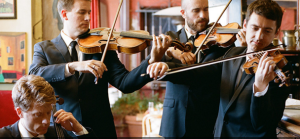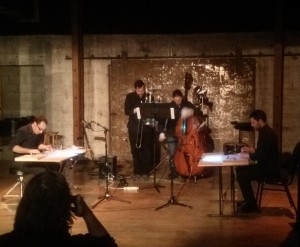 On Friday night, February 5, 2016 a good crowd braved the dreaded 101 freeway closure to travel downtown to Art Share LA . The occasion was …until… the first concert of 2016 for wasteLAnd music, marking the third year they have offered programs of new and experimental music in Los Angeles. Four pieces were performed – including a premiere – each incorporating traditional acoustic instruments accompanied by electronics.
On Friday night, February 5, 2016 a good crowd braved the dreaded 101 freeway closure to travel downtown to Art Share LA . The occasion was …until… the first concert of 2016 for wasteLAnd music, marking the third year they have offered programs of new and experimental music in Los Angeles. Four pieces were performed – including a premiere – each incorporating traditional acoustic instruments accompanied by electronics.
Scott Worthington was the double bass soloist on …until… #10, by Santa Barbara-based composer Clarence Barlow. This was the premiere performance and the inspiration for the concert title. …until… #10 begins with a steady electronic tone from a large speaker and this was joined by Worthington’s double bass. A series of moderately fast notes streamed out from the bass in repeating phrases that featured slight variations in the pattern of pitches and rhythms, but no overarching gestures or development. The notes were confined to the higher registers and none of the familiar deep, woody tones of the bass were heard. The mix with the electronic sound was quite complimentary, the warm tone from the speaker nicely filled up the nooks and crannies of the faster passages coming from the bass. Transient harmonies of bass notes against the electronic tone momentarily appeared and vanished, adding to the intrigue. There is a bright, bubbly optimism to this piece, effectively conveyed by the almost child-like melody. This pattern continued as the work progressed but the slight variations in rhythm and the sequence of the notes kept the listener actively engaged. …until… #10 is a masterful combination of simple electronics and refreshingly uninhibited musicality that envelops the listener with a cheerful buoyancy.
This was followed by Ilhas, by d’incise and this consisted of four snare drums with a player assigned to each along with a small, hand-held speaker. The speakers were placed face down on the drum heads, which were prepared with upturned plastic cups or boxes as well as other found objects. Soft electronic tones were heard and the speakers actuated the drum heads to produce a very light drum roll. The result was a pleasantly calming effect, like hearing an organ prelude in a soft rain. The electronic tones were sustained for a few seconds at a time, and the players adjusted the position of the speakers to achieve different effects. The speakers were moved from the center of the drum to the edges and at times the speakers were covered by the plastic cups or a box to concentrate and direct the energy to the drum head. The drum tension was adjusted and occasionally the speakers were lifted up slightly to vary the timbre and intensity of the drum head response. There was no scoring for this – it was up to each player to find the best place to maximize the various effects. Matt Barbier, Justin DeHart, Cory Hills and Scott Worthington were all effective in drawing out subtle differences in timbre and texture. Ilhas is an understated yet engaging work that is both inventive and surprisingly tranquil, given that it is performed with four snare drums.
Next was Commitment :: Ritual I ::BiiM, by Jessie Marino. And this was performed by Cory Hills with a single snare drum and lamp stand. The room was completely darkened and the piece began with a sharp rap on the drum followed by a short flash of bright light from a single lamp – and then a few seconds of silence. This sequence was then repeated. The sudden sound and bright flash of light was quite startling – the loss of visual references in the total darkness sharpened the senses and when the sounds and flashes occurred, it multiplied the effect. As the piece progressed the sequence changed so that the lamp flashed before the drum was heard. The beginning section invited your brain to associate the light and the sound together so when the light flashed first, the effect of the sound was that much more alarming. The feeling was reminiscent of a thunder storm at night – a flash of lightening closely followed by a loud thunder clap. Commitment :: Ritual I ::BiiM is an dauntingly instructive demonstration of the power of sensory conditioning on ear and eye.
The final work on the program was untitled three part construction by Michelle Lou, who is the featured composer for the current season of wasteLAnd concerts. For this Justin DeHart and Cory Hills were seated at desks containing a number of mechanical objects and one tape recorder. Matt Barbier and Scott Worthington shared a music stand, with muted trombone and double bass, respectively. Low, rough notes from the amplified double bass opened the piece while the trombone added a series of sharp repeating notes. Mechanical clickers were heard and more mechanical electronic sounds came from a speaker. As the clicking and clacking continued, ratchet wrenches were applied to stationary bolts and twirled backwards, introducing a light metallic ringing to the texture that added to the impression of being inside some sort of operating machine. At times, smooth tones from the bass made for a nice contrast with the clatter; at other times all was continuous rattling, commotion and roar. The feeling, however, was one of virtuous and industrious intent, free from any trace of malice.
About midway through the piece there was a sudden, measured silence, followed by a high pitched note from the double bass, as if hearing a siren at a distance. Knocking and scraping sounds ensued from the electronics, adding a distinct feeling of anxiety. The siren tones increased and the trombone added a deep growling sound. A piece like this invites the listener to create a story around the sequence of sounds – was that the drone of bombers overhead? The thud of bombs falling in the distance? The clicking and knocking increased and the tape recording added more anxious sounds. The double bass and trombone added a few rugged low notes and exited the stage. The tape increased its intensity and finally became disconcertingly chaotic before a sudden silence concluded the piece. untitled three part construction is a marvelously creative combination of sounds and musical tones that invite the listener to inhabit the unfolding drama of one’s own invention.
The next wasteLAnd concert, titled point/wave, will be on February 26, 2016 at Art Share LA.

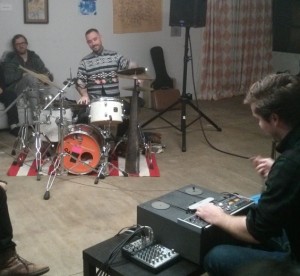
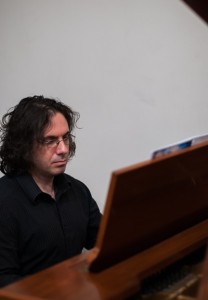



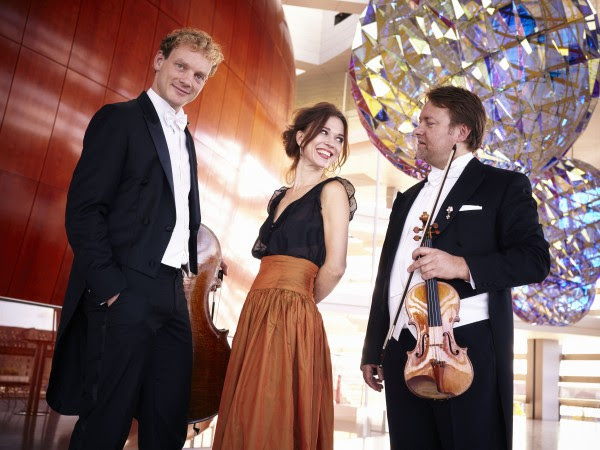 Photo: THOMAS GRØNDAHL
Photo: THOMAS GRØNDAHL
